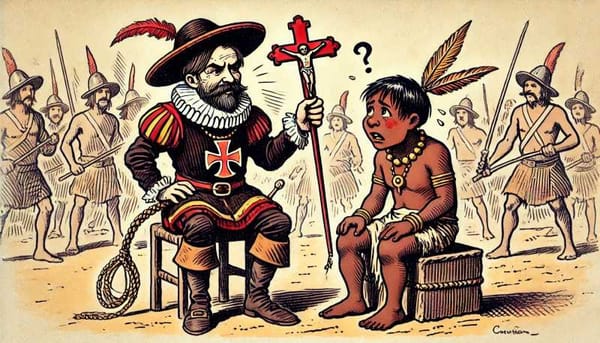Let's discover the Mayan Universe and their astronomical calendar
Discover in a simple and concise way, a small part of the vast universe of knowledge and culture that surrounds the Maya and information about the astronomical calendar.

For the Mayans, the conception of the universe goes beyond their own understanding; it is a global vision that involves beliefs, culture, religion, and of course, the perfect mechanics of the movements of the stars. This close relationship of what they saw and believed generated a coarse knowledge of the measurement of time and a beautiful interpretation of creation, based on the rich natural environment in which they lived.
This is a compilation of basic information about the Mayan astronomical culture. The main objective is to highlight the richness that this culture possesses, especially in time measurement which is only the beginning of a new era according to the Mayan calendar.
Discover in a simple and concise way, a small part of the vast universe of knowledge and culture that involves the Mayas; as based on precise measurements of the position of the stars with naked eye methods and few tools, they were able to generate tables and data, understanding the mechanics of the heavens, and even shaping it in their own buildings oriented according to the cosmos.

Cosmology
The universe in which man lives is conceived by the Mayans as a complex structure of superimposed horizontal levels, populated by sacred forces. The cosmos then began with the superior level of heaven, divided into thirteen levels; the earth where the man lived, represented as a rectangular plate; and the underworld, divided in turn into nine layers. These three main cosmic spaces are divided horizontally into four parts or directions, associated with colors and symbols of the ritual calendar, one could say that as the four cardinal points.
From the Codex Madrid in "the four sectors of the cosmos", it can be observed that in each earthly direction, and participating in the associated color, there is a sacred tree (Ia ceiba) and a bird, also divine, that seem to hold the celestial pyramid, next to four anthropomorphic gods, the Bacabes. And in the center of the earth stands the so-called "mother ceiba" whose roots communicate the earth plane with the underworld, and whose branches penetrate the celestial level.
The Codices
The Mayan Codices (from the Latin Codex, which is interpreted as a manuscript book) are, so far, one of the most valuable written records about this culture available to us. These documents are made of large sheets of amate paper, which was prepared by crushing the bark of the tree of the same name, then cooked in water with lime and spread. These leaves are very different from the current preparation of the paper we know and it is more like a textile fiber. They were then written on using inks prepared in shades of black, red, yellow, and blue. In the end, they were folded like an accordion in segments of 10x23cm, although this measure was variable.
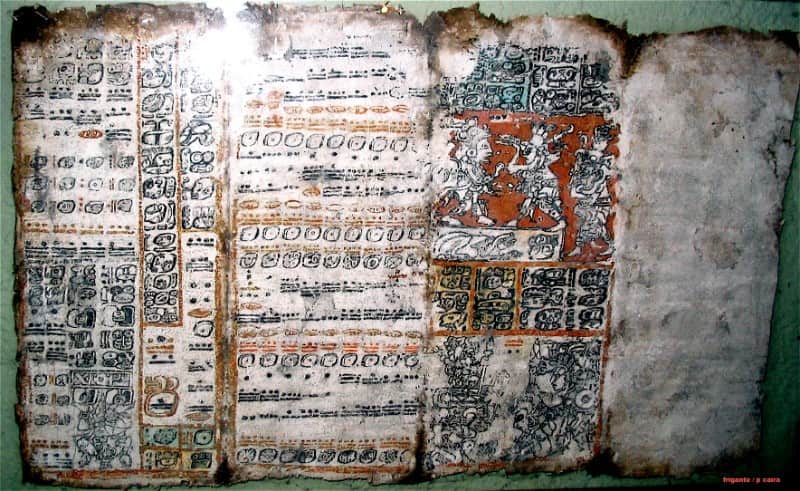
To this day, only three codices have survived, of which the authenticity can be verified. They are the Dresden, Paris, and Madrid, plus a fourth called Grolier of which there are still doubts about its authenticity. The names of these codices belong to the city in which they are kept. With the arrival of the Spaniards to the Yucatan peninsula in the 16th century, most of the documents found were burned on the instructions of Fray Diego de Landa in 1562, considering them negative for the process of evangelization. Alonso de Zorita wrote that in 1540, he saw these books in the Altiplano of Guatemala that "narrated their history of more than eight hundred years ago and were interpreted by very old indigenous people".
Popol Vuh
This is the most important record of the Quiche Mayan culture that remains today. In it, there is historical content and it reveals the mythological beliefs and literary qualities of this civilization. Some scholars of the subject place it with importance comparable to the Greek Iliad and Odyssey.
The very name Popol Vuh (Book of Counsel) refers to its use; ancient Mayan lords consulted pictorial manuscripts during meetings where they discussed matters of government. The Quiche would have obtained the pictorial manuscript (from which the Latin alphabet version of the Popol Vuh known today was derived) during a pilgrimage to the eastern coast of the Yucatan peninsula, hence they also knew the document by the name of Saq Petenaq ch'aqa Palo (The light that came from the seaside).
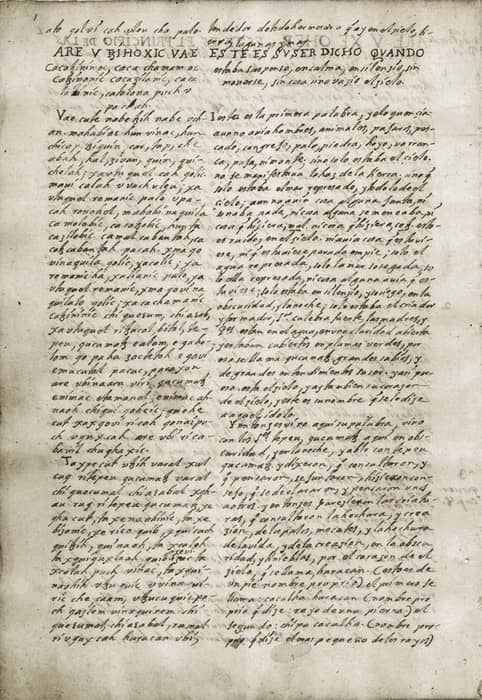
Much of this document is based on the extensive oral tradition in this area, accompanied by the reading of historical records, and those who compiled the Popol Vuh managed to transmit the history and religious beliefs of the ancient Maya of the Highlands without including elements of the European colonizers.
The creation of the world - Fragment of the Popol Vuh
This is the account of how everything was in suspense, everything quiet in silence; everything still, silent and empty expanse of heaven. This is the first relationship, the first speech. There was not yet a man, nor an animal, birds, fish, crabs, trees, stones, caves, ravines, grasses, or forests: only the sky existed.
The face of the earth did not manifest itself. There was only the calm sea and the sky in its entirety. There was nothing together, making a noise, nor anything moving, stirring, or making a sound in the sky. There was nothing that stood; only the water at rest, the sea peaceful, only quiet. There was nothing endowed with existence.
There was only stillness and silence in the darkness, in the night. Only the Creator, the Formator, Tepeu, Gucumatz, the Progenitors, were in the water surrounded by clarity. They were hidden under green and blue feathers.
Then the word came here, Tepeu and Gucumatz came together, in the darkness, in the night, and Tepeu and Gucumatz spoke to each other. And they talked together in consultation and in meditation, and they agreed and joined their words and their thoughts together. Then it became clear to them, as they meditated, that when daylight came, the man should appear. Then they arranged for the creation and growth of trees and other creatures and the birth of life and clarity in the action of man. It was thus arranged in the darkness and in the night by the Heart of Heaven, which is called Hurricane.
The first is called Caculhá Huracán. The second is Chipi-Caculhá. The third is Raxa-Caculhá and these three are the Heart of Heaven.
Then came together Tepeu and Gugumatz; then they conferred on life and clarity, how it will be done to make it clear and dawn, who will be the one to produce food and sustenance.
-Let the void be filled, let this water be withdrawn and the space be empty, let the land will emerge and assert itself! So they said. Let it shine, let it rise in heaven and on earth! There will be no glory or greatness in our creation and formation until there is the human creature, the formed man. So they said.
Then the earth was created by them. This is indeed how the creation of the land:
- Land, they said, and at once it was made.
Like the mist, like the cloud, and like the dust was the creation, when the mountains came up out of the water; and immediately the mountains grew.
Dresden Codex
This codex appeared in 1739 in Vienna, when Johann Christian Götze, Director of the Royal Library in Dresden, Germany, obtained it from a private collector. In 1744, it became the property of the Royal Library, now called the Sächsische Landesbibliothek. However, this important document suffered considerable damage during a bombardment in the Second World War when it became contaminated with water, so the very accurate reproductions made in 1810 and 1825 become very important.
The Dresden is a compilation very rich in astronomical references, about the worldview, rituals, and of course, the calendar, and is certainly of special importance since it was the basis for the understanding of the Mayan calendar and the recording of historical dates. The manuscript is a single sheet folded into 39 segments, written by both Ides. Among the main themes are sections dedicated to the lunar deity, the cycles of Venus linked to the Sun and the Moon, lunar tables, a flood, new year rituals, and agricultural cycles, as well as tables of multiples of various numbers.
For example, pages 25 to 28 show rituals associated with the end of the 365-day cycle and the beginning of the next. The annual period has been divided into 18 sections of 20 days with their respective names, followed by an additional section of five days, the uayeb. The contents of the sheet can be related to the descriptions of the new year ceremonies recorded in the Relación de las Cosas Yucatán (Relation of Things in the Yucatan), attributed to Fray Diego de Landa.

Venus cycles
On pages 46 to 50, the Dresden codex includes a Venus calendar, showing that the Maya had a more complex calendar associated with ceremonial ideas. It is remarkable how important Venus was to the Maya, who knew it under various names: Xux Ek or wasp star; Nok Ek, the great star, and Sastal Ek, the bright star, among others. Venus is associated with Kukulcan among the Mayas, the Mayan equivalent of Quetzalcoatl.
On each of the pages of Venus, there are four columns, each with thirty of the signs used in the 260-day calendar called tzolkin. Each of the signs represents the day in the tzolkin where a particular position of one of the five periods of Venus has begun that complements eight years of 365 days. The four columns on each particular page represent Venus in its position as the upper conjunction, the morning star, the lower conjunction, and the evening star. At the bottom of each page, the number of days of each period is shown in Mayan numbers.
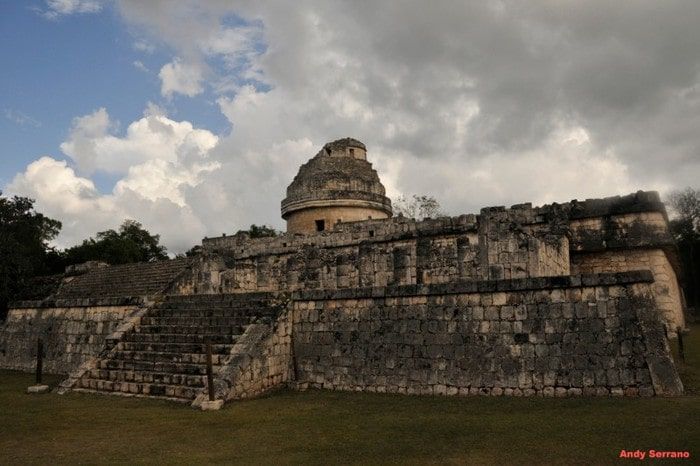
Astronomical directions
Practically every Mayan city built, presents astronomical characteristics in its orientation and form, its importance is based on the fact that they are aligned with respect to the sky in such a way that they serve as true stone calendars on dates that were important to the Mayan people.
To cite one of the best-known examples of astronomically oriented buildings, one can find in Chichen Itza "El Caracol" or also called "The Observatory", built with facades, slots, and observation holes, specially oriented to focus on specific sidereal events. The building is deliberately deviated from the alignment of its main platform, with the intention that its opposite East-West corners point to the sunrise at the summer solstice, and the sunset at the winter solstice.
The main platform is perfectly aligned to the setting of Venus at its maximum northern declination. The base of the observatory points to the sunset as it passes through Zenith. And some of the windows and slots on the Caracol point towards the Canopus and Castor stars. This is to mention some of the 29 well-documented alignments.
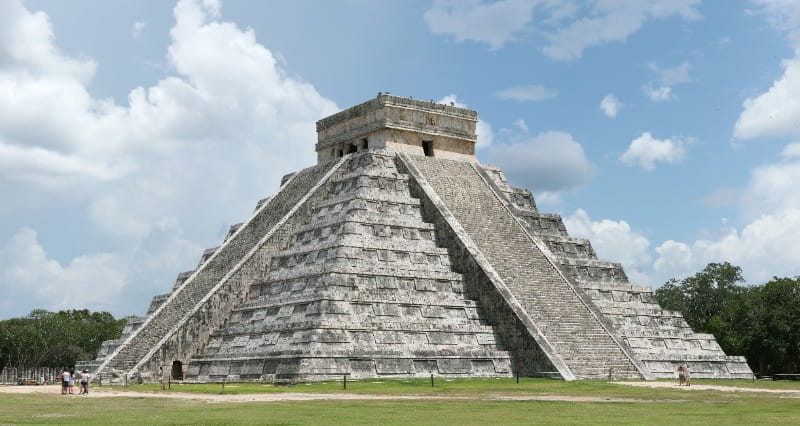
Calendars and long counts
For the Mayans, most of their mathematical knowledge focused on measuring time, the movements of the stars and planets, and there it is possible to see a profound mix of religion and calendar. So, the Mayas had several calendars, which ran at the same time.
The Tzolkin or sacred calendar with a duration of 260 days that was divided into 20 months with 13 numerals each month; The Haab has 365 days like our current calendar, but this one was divided into 18 months of 20 days, besides they added 5 additional days called uayeb, which were considered nefarious and excluded from the records, although if they were taken into account in the measurement of the year. These two calendars coincided again with the same date every 52 years (18,980 days). For the Mayans, the days were called "kin", the months "uinal" and the year "tun".
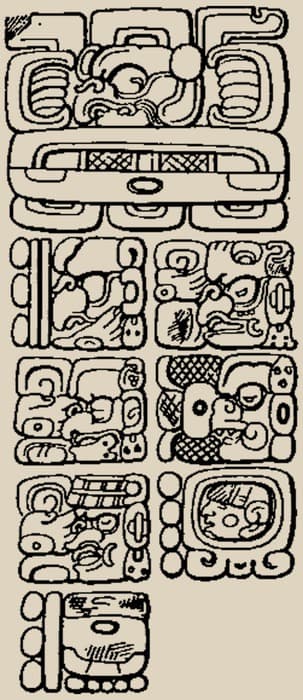
These two calendars only measure 52 years, so they needed to add a timeline indicator, so the long count marks cycles of 5125 years; according to archaeologists, the Mayan number 0.0 0.0.0 (4 Ahau 8 Cumku) is equivalent to the day August 11, 3114 BC. For this culture the measurement of time was essential, however, in no stele or codex has been found any prophecy of the end of the world, only interpreting the closing of a cycle, to start a new one.




